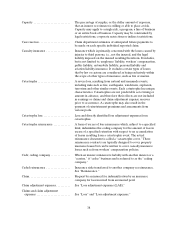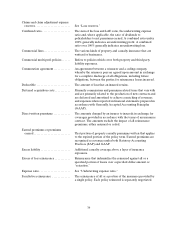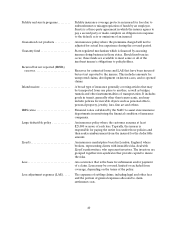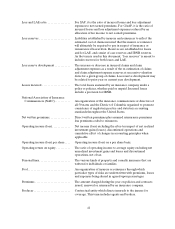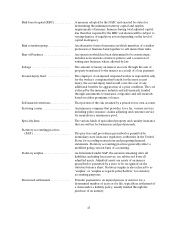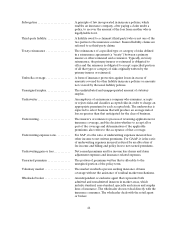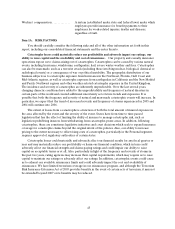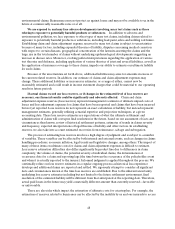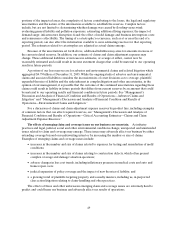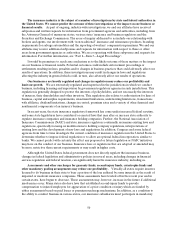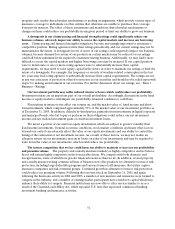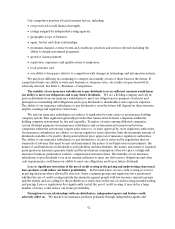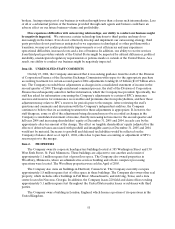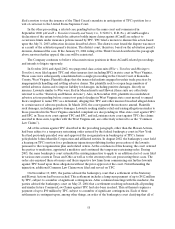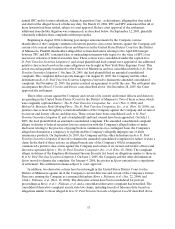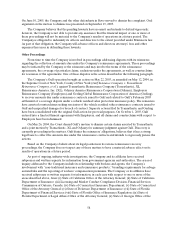Travelers 2005 Annual Report Download - page 60
Download and view the complete annual report
Please find page 60 of the 2005 Travelers annual report below. You can navigate through the pages in the report by either clicking on the pages listed below, or by using the keyword search tool below to find specific information within the annual report.48
environmental claims. Reinsurance may not protect us against losses and may not bea
vailable to us in the
future at commercially reasonable rates or at all.
We are exposed to, and may face adverse developments involving, mass tort claims such as those
relating to exposure to potentially harmful products or substances. In addition to asbestos and
environmental pollution, we face exposure to other types of mass tort claims, including claims related to
exposure to potentially harmful products or substances, including lead paint,silica and welding rod fumes.
Establishing claim and claim adjustment expense reserves for mass tort claims is subject to uncertainties
because of many factors, including expanded theories of liability, disputes concerning medical causation
with respect to certain diseases, geographical concentration of the lawsuits asserting the claims and the
large rise in the total number of claims without underlying epidemiological developments suggesting an
increase in disease rates. Moreover, evolvingjudicial interpretations regarding the application of various
tort theories and defenses, including application of various theories of joint and several liabilities, as well as
the application of insurance coverage to these claims, impede our ability to estimate our ultimate liability
for such claims.
Because of the uncertainties set forth above, additional liabilities may arise for amounts in excess of
the current related reserves. In addition, our estimate of claims and claim adjustment expenses may
change. These additional liabilities or increases in estimates, or a range of either, cannot now be
reasonably estimated and could result in income statement charges that could be material to our operating
results in future periods.
If actual claims exceed our loss reserves, or if changes in the estimated level of loss reserves are
necessary, our financial results could be significantly and adversely affected. Claim and claim
adjustment expense reserves (loss reserves) represent management’s estimate of ultimate unpaid costs of
losses and loss adjustment expenses for claims that have been reported and claims that have been incurred
but not yet reported. Loss reserves do not represent an exact calculation of liability, but instead represent
management estimates, generally utilizing actuarial expertise and projection techniques, at a given
accounting date. These loss reserve estimates are expectationsof what the ultimate settlement and
administration of claims will cost upon final resolution in the future, based on our assessment of facts and
circumstances then known, review of historical settlement patterns, estimates of trends in claims severity
and frequency, expected interpretations of legal theories of liability and other factors. In establishing
reserves, we also take into account estimated recoveries from reinsurance, salvage and subrogation.
The process of estimating loss reserves involves a high degree of judgment and is subject to a number
of variables. These variables can be affected by both internal and external events, such as changes in claims
handling procedures, economic inflation, legal trends and legislative changes, among others. The impact of
many of these items on ultimate costs for claims andclaim adjustment expenses is difficult to estimate.
Loss reserve estimation difficulties also differ significantly by product line due to differences in claim
complexity, the volume of claims, the potential severity of individual claims, the determination of
occurrence date for a claim and reporting lags (the time between the occurrence of the policyholder event
and when it is actually reported to the insurer). Informed judgment is applied throughout the process. We
continually refineour loss reserve estimates in a regular ongoing process as historical loss experience
develops and additional claims are reported and settled. We rigorously attempt to consider all significant
facts and circumstances known at the time loss reservesare established. Due to the inherent uncertainty
underlying loss reserve estimates including but not limited to the future settlement environment, final
resolution of the estimated liability will be differentfrom that anticipated at the reporting date. Therefore,
actual paid losses in the future may yield a materially different amount than currently reserved—favorable
or unfavorable.
There are also risks which impact the estimation ofultimate costs for catastrophes. For example, the
estimation of reserves related to hurricanes can be affected by the inability by us and our insureds to access


